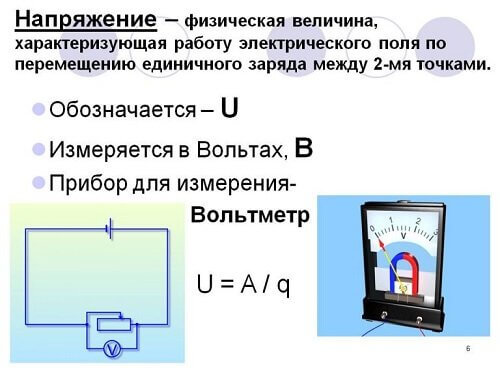What still beats: current or voltage?
At an early age, many of us were convinced from our own experience or learned from eyewitnesses that if you plug the iron into a power outlet and try to cut the power cord, you will definitely experience a painful blow. So an electric current acts on the body. At school, they write over sockets: “220 V, it will be dangerous, it will kill!”. At substations, in transformer booths and in other high-voltage installations, warning signs are posted: “Danger to life, high voltage!”. So what exactly is a danger to humans and why? What hits: current or voltage? To begin with, we will understand these concepts.
Voltage Conditions
Any substance consists of atoms having a positive nucleus and negatively charged electrons.
If, under the influence of external forces, a certain number of electrons is taken away from the atoms, then the resulting positive field will tend to return new negative particles to their place.
If electrons are not taken away but added, then the field will have a negative charge. This creates positive and negative potentials. In the interaction between them there is an attractive force. The larger the potential difference, the stronger the field and high voltage is formed.
How does the current arise
If using a conductor to connect the potentials of opposite charges, then there will be a directed movement of charged particles the so-called electricityseeking to eliminate the potential difference.
It is the directional movement of charged particles that makes our electrical appliances perform a useful action: to shine, wash, warm, drill and so on. The larger the potential difference, the higher the current strength. If the circuit is opened, the current will not flow, no matter how high the voltage would be.
Effects on the body
The human body, being a conductor, can short circuit an electric circuit. Then a current will flow through the body, the strength of which is determined by the formula:
I = U / R, where:
- U is the magnitude of the voltage applied to the person;
- R is the resistance of the body.
At this moment, the body is damaged.
The table shows which current is considered dangerous for humans:
- 15 mA, non-releasing value, self-release is not possible;
- 50 mA leads to cardiac fibrillation, respiratory arrest, death;
- 200 mA causes severe burns incompatible with life.
Shock occurs at voltages up to 1000 volts. Above this value, the lesion takes the form of burns.
Even without direct contact with high voltage equipment, a person can be fatally injured. So, when staying in dangerously close to a high-voltage installation, between the body and the conductive parts electric arcaccompanied by:
- bright flash hazardous to vision;
- instant heating of air to 10 000-15 000 degrees Celsius;
- melting and evaporation of metals, the formation of aerosols.
The consequences of an arc discharge cause a burn injury to a person that is incompatible with life.
For the operation of protective automation requires scanty time. But, when an arc occurs, a huge amount of energy is released, which kills a person in such a short time.
Factors affecting the degree of damage
DC shock is dangerous. But you can get rid of its effects without the help of outsiders at values from 20 to 25 mA.
Dangerous effects on the body of alternating current with a frequency of 50 - 500 Hz. A person can independently get rid of his influence only at very low values, ranging from 9 to 10 mA.
What current strength in the circuit depends on the voltage in this circuit and the resistance of all its elements, including the resistance of the human body. Dry skin has a higher resistance of approximately 100,000 ohms. Humid - only about 1000 ohms. The resistance of internal organs is in the range of 500-1000 ohms.
If the voltage applied to the body increases, the body's resistance decreases disproportionately. The same thing happens with an increase in the duration of exposure to electricity, as well as with a poor physical and mental condition of a person.
The graph shows that if the voltage increases from 0 to 140 volts, the resistance of the body drops from 10,000 to 800 ohms. This nonlinear dependence is reflected in the first curve. The second curve shows that the current passing through the human body increases with increasing voltage.
How severe an electric shock will be depends on the time it is exposed to the body. If the effect lasts several seconds, the resistance of the body decreases, respectively, the current increases, which leads to serious consequences. If the exposure time is less than a tenth of a second, then the likelihood of cardiac fibrillation is reduced, and the likelihood of saving life increases.
From the table it follows that, for a favorable outcome, the duration of exposure to 65 mA at rated 65 V should not exceed 1 second.
I repeat that in the table of rated currents for different voltages of the resistance of the body it is accepted as 1000 Ohm, in reality it is impossible to predict the magnitude of the current, since the resistance of the body depends on a number of factors.
The mechanism of the effect of electricity on the human body is complex. It happened when in high-voltage installations a short blow of several amperes did not lead to death. Whereas a voltage of 12-36 V and a current of several milliamps were fatal to humans. The reason is a lesion caused by touching the conductors of the most vulnerable part of the body: neck, cheek, shoulder, back of the hand.
Conclusion
So what kills: current or voltage?
Since the electric current is an ordered movement of charged particles, and the voltage is one of the characteristics of the electric field, under the influence of which this movement occurs, we can assume that the voltage is primary.
But it kills the electric current, because it is it that flows through the body of a person, but it cannot flow through the body if the voltage is too low.
It turns out a pun - it kills the current, but without voltage the current will not flow. Be careful, do not check the veracity of the inscription "high voltage". And then you are not afraid of any blow, including an electric one.
We also recommend watching a video where the author clearly illustrates the topic of this article:
Related materials:









